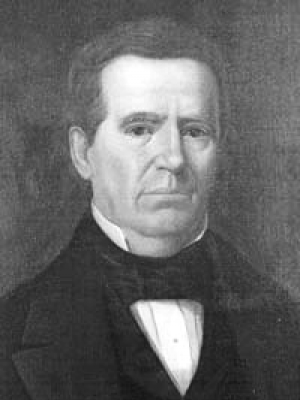
In 1833 Jones headed to Texas, settling eventually in Brazoria. Here, he met with success, establishing a medical practice that prospered quickly. In 1835 he attended The Consultation, a meeting held at Columbia by Texas patriots to discuss independence from Mexico. Jones himself presented a resolution at the Consultation calling for a convention to be held to declare independence, but he himself refused to be nominated to the convention.
During the Texas Revolution, Jones served as a judge advocate and surgeon to the Texas army, though he insisted on holding the rank of private throughout the conflict. After the war, Jones returned to Brazoria and resumed his medical practice.
Jones was elected to the Second Texas Congress. His most significant act in Congress was to call for the withdrawal of the Texas proposal for annexation by the United States. He also helped draw up legislation to regulate medical practice, and called for the establishment of an endowment for a university.
Jones expected to return to his practice at Brazoria after his term in Congress, but Texas President Sam Houston instead appointed him Minister to the United States, where Jones was to formally withdraw the annexation proposal.
During this time, while many Texans hoped to encourage eventual annexation by the United States, there were some who supported waiting for annexation or even remaining independent. The United States, in the late 1830s, was hesitant to annex Texas for fear of provoking a war with Mexico. Jones and others felt it was important that Texas gain recognition from European states and begin to set up trade relations with them, to make annexation of Texas more attractive to the United States or, failing that, to give Texas the strength to remain independent.
Jones was recalled to Texas by new President Mirabeau Lamar in 1839. Back at home, he found himself elected to a partial term in the Senate, where he quickly became a critic of Lamar's administration. He retired from the Senate in 1841, declining the opportunity to serve as Vice President in favor of returning to his medical practice. However, late in 1841 he was named Texas Secretary of State by President Sam Houston, who had been recently been elected President again by opponents of Lamar. Jones served as Secretary of State until 1844. During his term, the main goal of Texas foreign policy was to get either an offer of annexation from the United States, a recognition of Texas independence from Mexico, or, preferably, both at the same time.
In September 1844, Jones was elected President of the Republic of Texas, despite running a virtually silent campaign. That November, James K. Polk was elected President of the United States on a promise of Texas annexation. However, Jones held his silence on the subject, preferring to wait for the ideal outcome of simultaneous annexation and independence offers. This proved unpopular. Late in 1844, the Texas Congress declared for joining the United States, and popular sentiment in the republic for annexation grew.
Finally, in June 1845, Jones' emissary to Mexico returned with a treaty recognizing the republic's independence. At last he put the question before the people accept the offer of annexation from the United States, or sign the independence treaty from Mexico and remain an independent state. The Congress and the people went for annexation.
Preparations began for annexation, and Jones' role as President was greatly diminished. On Feb. 19, 1846, a formal ceremony was held to bring Texas into the United States. Jones, in his last official act, declared that, "The Republic of Texas is no more." Then he retired to Brazoria.
Source: Wikipedia
